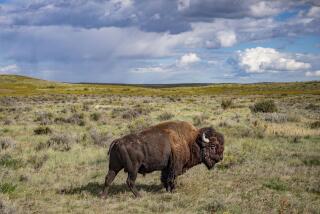Bring-Back-the-Bison Idea No Washout : Great Plains: Proposal to supplant people with buffalo gains standing as ghost towns multiply across prairie.
- Share via
WASHINGTON — Seven years ago, Frank and Deborah Popper, two academics from the East, tore up heartland America with a startling notion: The Great Plains would--and maybe should--be almost emptied of people and returned to the buffalo.
Now the Poppers are back, with a new research paper that says that much of what they predicted is already happening, though not as severely as they first thought.
The outrage was palpable when they made their forecast. People accused them of plotting urban renewal in small-town America.
From Abilene to Dodge City, this husband-and-wife team’s prediction of the formation of a “Buffalo Common” rangeland ran into ridicule and denunciation, even a death threat. But it spurred a lot of thinking about the future of the prairie states.
Inevitably, claim the Poppers, the landscape--”nearly treeless, semiarid, austerely beautiful, historically untenable”--is returning to its natural state in vast swaths.
But people are finding new ways to cope and to stay--a tendency the Poppers did not fully recognize in 1987.
“It’s not a decline scenario,” said Frank Popper, who teaches urban studies at Rutgers University in New Jersey. His wife teaches geography at the College of Staten Island, a branch of City University of New York.
They had predicted it would take 20 to 30 years for vegetation and wildlife to reassert themselves and restore the Plains to their “pre-white conditions” outside of a handful of population centers.
As evidence that it’s starting to happen, the Poppers cite statistics: hundreds of ghost towns in Kansas; 5,000 to 10,000 deserted farmhouses in Nebraska; population drop-offs in 38 of the 41 counties of North Dakota, 22 of the 23 counties in Oklahoma, 50 of the 52 Plains counties in Nebraska.
Young people especially are dwindling in numbers. Tim Borich, a rural sociologist, says there are more people in Iowa over age 75 than under 5.
“In a generation,” the Poppers still say, “large parts of the rural Plains will be far emptier, more frontier-like than today.”
But now they say those who remain often will find livelihoods as custodians, rather than only as users, of the land.
They still foresee a role for the bison.
“Ranchers can easily switch to buffalo and selling hunting rights, meats, hides, horns and skulls and health prices,” they say. “Bison are less laborious to tend than cattle, better able to withstand Plains winters and easier on the land. Buffalo meat has more protein and less fat and cholesterol than beef.”
Sales of buffalo exceed 12,500 a year; one consortium of Indian tribes foresees sales of 20,000 for itself. Canadians, too, eye the buffalo as a resource.
But prairie people, well-educated, self-sustaining, highly motivated, aren’t especially eager to turn in their plows so they can pump gasoline for tourists or serve them breakfast.
Sen. Thomas Daschle (D-S.D.) rejects the Popper scenario. He sees the agricultural economy saving itself by turning toward end-use ventures. The Poppers, he said, “took an element of truth and magnified it and created a distorted picture.”
Daschle cites a home-state enterprise he visited that mixes soybean meal with recycled plastic milk cartons to create a product tougher than wood.
“We’ve got to be more than just a raw agricultural product exporter,” Daschle said. “We’ve got to add value.”
He sees the information revolution as helping. When he grew up, people shared a party-line phone with as many as 10 families. On a recent stay, he rented a rural motel room and made international calls and sent and received faxes. “I could have been in Washington or London,” he said.
More to Read
Sign up for Essential California
The most important California stories and recommendations in your inbox every morning.
You may occasionally receive promotional content from the Los Angeles Times.











